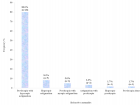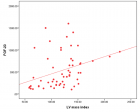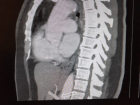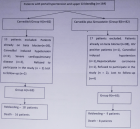Abstract
Research Article
Adaptive planning and toxicities of uniform scanning proton therapy for lung cancer patients
Yuanshui Zheng*, Hardev Singh, Suresh Rana, Gary Larson, Prabhu Kiran, Lucius Doh and James Wong
Published: 10 September, 2018 | Volume 2 - Issue 3 | Pages: 055-061
Purpose: Adaptive planning is often needed in lung cancer proton therapy to account for geometrical variations, such as tumor shrinkage and other anatomical changes. The purpose of this study is to present our findings in adaptive radiotherapy for lung cancer using uniform scanning proton beams, including clinical workflow, adaptation strategies and considerations, and toxicities.
Methods: We analyzed 165 lung patients treated using uniform scanning proton beams at our center. Quality assurance (QA) plans were generated after repeated computerized tomography (CT) scan to evaluate anatomic and dosimetric change during the course of treatment. Plan adaptation was determined mutually by physicists and physicians after QA plan evaluation, based on several clinical and practical considerations including potential clinical benefit and associated cost in plan adaption. Detailed analysis was performed for all patients with a plan adaptation, including the type of anatomy change, at which fraction the adaption was made, and the strategy for adaptation. Toxicities were compared between patients with and without plan adaptation.
Results: In total, 32 adaptive plans were made for 31 patients out of 165 patients, with one patient undergoing adaptive planning twice. Anatomy changes leading to plan adaptation included tumor shrinkage (17), pleural effusion (3), patient weight loss (2), and tumor growth or other anatomy change (9). The plan adaptation occurred at the 15th fraction on average and ranged from the 1st to 31st fraction. Strategies of plan adaptation included range change only (18), re-planning with new patient-specific hardware (9), and others (5). Most toxicities were Grade 1 or 2, with dermatitis the highest toxicity rate.
Conclusion: Adaptive planning is necessary in proton therapy to account for anatomy change and its effect on proton penetration depth during the course of treatment. It is important to take practical considerations into account and fully understand the limitations of plan adaptation process and tools to make wise decision on adaptive planning. USPT is a safe treatment for lung cancer patients with no Grade 4 toxicity.
Read Full Article HTML DOI: 10.29328/journal.jro.1001023 Cite this Article Read Full Article PDF
Keywords:
Uniform scanning; Proton therapy; Lung cancer; Adaptive radiotherapy
References
- DeLaney TF, Kooy HM. Proton and Charged Particle Radiotherapy. 2015: Wolters Kluwer Health.
- Paganetti H. Proton Therapy Physics. 2011: Taylor & Francis. Ref.: https://goo.gl/dSHSA5
- Zheng Y, Ramirez E, Mascia A, Ding X, Okoth B, et al. Commissioning of output factors for uniform scanning proton beams. Med Phys. 2011; 38: 2299-2306. Ref.: https://goo.gl/5A11nN
- Cushman TR, Verma V, Rwigema JM. Comparison of proton therapy and intensity modulated photon radiotherapy for locally advanced non-small cell lung cancer: considerations for optimal trial design. J Thorac Dis. 2018; 10(Suppl 9): S988-S990. Ref.: https://goo.gl/hDJ5cw
- Wu CT, Motegi A, Motegi K, Hotta K, Kohno R, et al. Dosimetric comparison between proton beam therapy and photon radiation therapy for locally advanced non-small cell lung cancer. Jpn J Clin Oncol. 2016; Ref.: https://goo.gl/zRAoAi
- Ohno T, Oshiro Y, Mizumoto M, Numajiri H, Ishikawa H, et al. Comparison of dose-volume histograms between proton beam and X-ray conformal radiotherapy for locally advanced non-small-cell lung cancer. J Radiat Res. 2015; 56: 128-133. Ref.: https://goo.gl/ZAEV5J
- Stuschke M, Kaiser A, Pöttgen C, Lübcke W, Farr J. Potentials of robust intensity modulated scanning proton plans for locally advanced lung cancer in comparison to intensity modulated photon plans. Radiother Oncol. 2012; 104: 45-51. Ref.: https://goo.gl/vR3bxv
- Seco J, Panahandeh HR, Westover K, Adams J, Willers H. Treatment of non-small cell lung cancer patients with proton beam-based stereotactic body radiotherapy: dosimetric comparison with photon plans highlights importance of range uncertainty. Int J Radiat Oncol Biol Phys. 2012; 83: 354-361. Ref.: https://goo.gl/9qDbxL
- Hoppe BS, Huh S, Flampouri S, Nichols RC, Oliver KR, et al. Double-scattered proton-based stereotactic body radiotherapy for stage I lung cancer: a dosimetric comparison with photon-based stereotactic body radiotherapy. Radiother Oncol. 2010; 97: 425-430. Ref.: https://goo.gl/fC33ym
- Kadoya N, Obata Y, Kato T, Kagiya M, Nakamura T, et al. Dose-volume comparison of proton radiotherapy and stereotactic body radiotherapy for non-small-cell lung cancer. Int J Radiat Oncol Biol Phys. 2011; 79: 1225-1231. Ref.: https://goo.gl/PfccUY
- Chang JY, Zhang X, Wang X, Kang Y, Riley B. et al. Significant reduction of normal tissue dose by proton radiotherapy compared with three-dimensional conformal or intensity-modulated radiation therapy in Stage I or Stage III non-small-cell lung cancer. Int J Radiat Oncol Biol Phys. 2006; 65: 1087-1096. Ref.: https://goo.gl/CFxHxe
- Veiga C, Janssens G, Teng CL, Baudier T, Hotoiu L, et al. First Clinical Investigation of Cone Beam Computed Tomography and Deformable Registration for Adaptive Proton Therapy for Lung Cancer. Int J Radiat Oncol Biol Phys. 2016; 95: 549-559. Ref.: https://goo.gl/EoS9hd
- Zhang X1, Li Y, Pan X, Xiaoqiang L, Mohan R, et al. Intensity-modulated proton therapy reduces the dose to normal tissue compared with intensity-modulated radiation therapy or passive scattering proton therapy and enables individualized radical radiotherapy for extensive stage IIIB non-small-cell lung cancer: a virtual clinical study. Int J Radiat Oncol Biol Phys. 2010; 77: 357-366. Ref.: https://goo.gl/iDdbVs
- Zheng Y. Adaptive Radiotherapy for Lung Cancer Using Uniform Scanning Proton Beams, in Radiotherapy, C. Onal, Editor. 2017; IntechOpen. Ref.: https://goo.gl/kbSt3v
- Zhang M, Zou W, Teo BK. Image guidance in proton therapy for lung cancer. Transl Lung Cancer Res. 2018; 7: 160-170. Ref.: https://goo.gl/vSfn6B
- Koay EJ, Lege D, Mohan R, Komaki R, Cox JD, et al. Adaptive/nonadaptive proton radiation planning and outcomes in a phase II trial for locally advanced non-small cell lung cancer. Int J Radiat Oncol Biol Phys. 2012; 84: 1093-1000. Ref.: https://goo.gl/bqi4TP
- Chang JY, Li H, Zhu XR, Liao Z, Zhao L, et al. Clinical implementation of intensity modulated proton therapy for thoracic malignancies. Int J Radiat Oncol Biol Phys. 2014; 90: 809-818. Ref.: https://goo.gl/sQLNjc
- Chang JY, Komaki R, Wen HY, De Gracia B, Bluett JB, et al. Toxicity and patterns of failure of adaptive/ablative proton therapy for early-stage, medically inoperable non-small cell lung cancer. Int J Radiat Oncol Biol Phys. 2011; 80: 1350-1357. Ref.: https://goo.gl/cjm9G4
- Hua C, Yao W, Kidani T, Tomida K, Ozawa S, et al. A robotic C-arm cone beam CT system for image-guided proton therapy: design and performance. Br J Radiol. 2017. 90: 20170266. Ref.: https://goo.gl/XvBRjW
Figures:

Figure 1

Figure 2
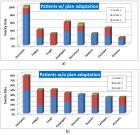
Figure 3
Similar Articles
-
Inter-Observer Variability of a Commercial Patient Positioning and Verification System in Proton TherapyYuanshui Zheng*,Xiaoning Ding. Inter-Observer Variability of a Commercial Patient Positioning and Verification System in Proton Therapy. . 2017 doi: 10.29328/journal.jro.1001004; 1: 031-038
-
Biological dose calculation using variable RBE in Single- and Multi-field Optimization IMPT plans for 3 Brain Tumor patientsRyosuke Kohno*,Wenhua Cao,Pablo Yepes,Xuemin Bai,Falk Poenisch,David R Grosshans,Tetsuo Akimoto,Radhe Mohan. Biological dose calculation using variable RBE in Single- and Multi-field Optimization IMPT plans for 3 Brain Tumor patients. . 2019 doi: 10.29328/journal.jro.1001027; 3: 001-007
-
Adaptive planning and toxicities of uniform scanning proton therapy for lung cancer patientsYuanshui Zheng*,Hardev Singh,Suresh Rana,Gary Larson,Prabhu Kiran,Lucius Doh,James Wong. Adaptive planning and toxicities of uniform scanning proton therapy for lung cancer patients. . 2018 doi: 10.29328/journal.jro.1001023; 2: 055-061
-
Incidental findings in traditional nuclear medicine practiceGiuseppe De Vincentis,Mariano Pontico,Maria Ricci,Viviana Frantellizzi*,Mauro Liberatore. Incidental findings in traditional nuclear medicine practice. . 2018 doi: 10.29328/journal.jro.1001019; 2: 036-040
-
Adrenal insufficiency in Bilateral Adrenal Metastasis implemented SBRTYasemin Benderli Cihan*. Adrenal insufficiency in Bilateral Adrenal Metastasis implemented SBRT. . 2018 doi: 10.29328/journal.jro.1001016; 2: 009-011
-
The Impacts of Angiotensin Receptor Blockers (ARBs) or Angiotensin-Converting Enzyme Inhibitors (ACEIs) on Patients with Stereotactic Body Radiation Therapy (SBRT) for Early-Stage NSCLCSaber A Amin, Morshed Alam, Bangchen Wang, Weining Zhen, Chi Lin, Apar Kishor Ganti, Vinicius Ernani, Alissa Marr, Tony JC Wang, Simon K Cheng, Michael Baine, Chi Zhang*. The Impacts of Angiotensin Receptor Blockers (ARBs) or Angiotensin-Converting Enzyme Inhibitors (ACEIs) on Patients with Stereotactic Body Radiation Therapy (SBRT) for Early-Stage NSCLC. . 2023 doi: 10.29328/journal.jro.1001050; 7: 033-041
Recently Viewed
-
Hypo-glycaemia and Associated Factors among Type 1 Diabetes Mellitus Patients Attending the Outpatient Clinics of Debre-tabor Compressive and Specialized Hospital, South Gondar Zone, North West Ethiopia: A Cross-sectional StudyLibsuye Yalgaw Zimamu*, Gashaw Mekete Adal, Gashaw Mehiret Wubet, Dessie Alemnew. Hypo-glycaemia and Associated Factors among Type 1 Diabetes Mellitus Patients Attending the Outpatient Clinics of Debre-tabor Compressive and Specialized Hospital, South Gondar Zone, North West Ethiopia: A Cross-sectional Study. J Community Med Health Solut. 2024: doi: 10.29328/journal.jcmhs.1001045; 5: 031-045
-
Drinking-water Quality Assessment in Selective Schools from the Mount LebanonWalaa Diab, Mona Farhat, Marwa Rammal, Chaden Moussa Haidar*, Ali Yaacoub, Alaa Hamzeh. Drinking-water Quality Assessment in Selective Schools from the Mount Lebanon. Ann Civil Environ Eng. 2024: doi: 10.29328/journal.acee.1001061; 8: 018-024
-
Chronic Ethanol Decreases the Left Ventricular Cardiac PerformanceCamargo VMB*, Damatto FC, Fioravante VC, Godoi AR, Stoppa EG, Okoshi MP, Okoshi K, Miranda JRA, Martinez FE. Chronic Ethanol Decreases the Left Ventricular Cardiac Performance. J Cardiol Cardiovasc Med. 2024: doi: 10.29328/journal.jccm.1001181; 9: 067-072
-
Correlation between the Values of Immature Platelet Fraction and Mean Platelet Volume with the Extent of Coronary Artery Disease in Patients with Non-ST-Segment Elevation Myocardial InfarctionShadab Rauf*, Tarun Kumar, Vijay Kumar, Ranjit Kumar Nath. Correlation between the Values of Immature Platelet Fraction and Mean Platelet Volume with the Extent of Coronary Artery Disease in Patients with Non-ST-Segment Elevation Myocardial Infarction. J Cardiol Cardiovasc Med. 2023: doi: 10.29328/journal.jccm.1001163; 8: 114-121
-
A Water-soluble Form of Dihydroquercetin Reduces LPS-induced Astrogliosis, Vascular Remodeling, and mRNA VEGF-A Levels in the Substantia Nigra of Aged RatsElena S Alalykina, Tatyana N Sergeeva, Michail A Ananyan*, Ivan A Cherenkov, Valeriy G Sergeev. A Water-soluble Form of Dihydroquercetin Reduces LPS-induced Astrogliosis, Vascular Remodeling, and mRNA VEGF-A Levels in the Substantia Nigra of Aged Rats. J Neurosci Neurol Disord. 2024: doi: 10.29328/journal.jnnd.1001092; 8: 014-019
Most Viewed
-
Evaluation of Biostimulants Based on Recovered Protein Hydrolysates from Animal By-products as Plant Growth EnhancersH Pérez-Aguilar*, M Lacruz-Asaro, F Arán-Ais. Evaluation of Biostimulants Based on Recovered Protein Hydrolysates from Animal By-products as Plant Growth Enhancers. J Plant Sci Phytopathol. 2023 doi: 10.29328/journal.jpsp.1001104; 7: 042-047
-
Feasibility study of magnetic sensing for detecting single-neuron action potentialsDenis Tonini,Kai Wu,Renata Saha,Jian-Ping Wang*. Feasibility study of magnetic sensing for detecting single-neuron action potentials. Ann Biomed Sci Eng. 2022 doi: 10.29328/journal.abse.1001018; 6: 019-029
-
Physical activity can change the physiological and psychological circumstances during COVID-19 pandemic: A narrative reviewKhashayar Maroufi*. Physical activity can change the physiological and psychological circumstances during COVID-19 pandemic: A narrative review. J Sports Med Ther. 2021 doi: 10.29328/journal.jsmt.1001051; 6: 001-007
-
Pediatric Dysgerminoma: Unveiling a Rare Ovarian TumorFaten Limaiem*, Khalil Saffar, Ahmed Halouani. Pediatric Dysgerminoma: Unveiling a Rare Ovarian Tumor. Arch Case Rep. 2024 doi: 10.29328/journal.acr.1001087; 8: 010-013
-
Prospective Coronavirus Liver Effects: Available KnowledgeAvishek Mandal*. Prospective Coronavirus Liver Effects: Available Knowledge. Ann Clin Gastroenterol Hepatol. 2023 doi: 10.29328/journal.acgh.1001039; 7: 001-010

HSPI: We're glad you're here. Please click "create a new Query" if you are a new visitor to our website and need further information from us.
If you are already a member of our network and need to keep track of any developments regarding a question you have already submitted, click "take me to my Query."






